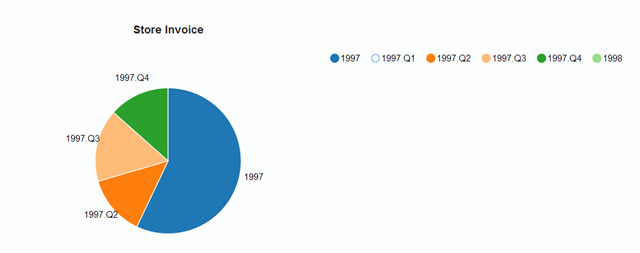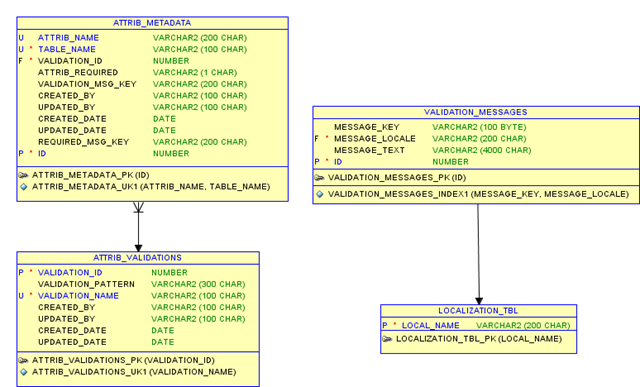To override the default error handler one can extend the DCErrorHandlerImpl. In this you can process the exceptions or can choose to suppress them. In this post i will explain a way to suppress the RowValException message and display only the detail entity attribute level exception ie AttrValException.
In ADF the exceptions are grouped and raised together as a single object. For example let's say that 2 of the attributes fail the mandatory validation then the exceptions raised for them will be 2 individual AttrValException these are then attached as detail objects into a RowValException and if there are many such RowValException they will be attached and raised together as a TxnValException.
So now to handle the aforementioned task we need to recursively process the exceptions and suppress the RowValException message. The snippet below shows that :-
In this snippet i am recursively processing TxnValException->RowValException -> AttrValException. The AttrValException is being passed in the super call to the DCErrorHandlerImpl to process and display the message.
In ADF the exceptions are grouped and raised together as a single object. For example let's say that 2 of the attributes fail the mandatory validation then the exceptions raised for them will be 2 individual AttrValException these are then attached as detail objects into a RowValException and if there are many such RowValException they will be attached and raised together as a TxnValException.
So now to handle the aforementioned task we need to recursively process the exceptions and suppress the RowValException message. The snippet below shows that :-
public class MyErrorHandler extends DCErrorHandlerImpl {
private static final ADFLogger logger = ADFLogger.createADFLogger(VleAdminErrorHandler.class);
private static ResourceBundle rb = ResourceBundle.getBundle("mypackage.myBundle");
public MyErrorHandler() {
super(true);
}
public MyErrorHandler(boolean setToThrow) {
super(setToThrow);
}
public void reportException(DCBindingContainer bc, java.lang.Exception ex) {
disableAppendCodes(ex);
logger.info("entering reportException() method");
BindingContext ctx = bc.getBindingContext();
String err_code;
err_code = null;
if(ex instanceof NullPointerException){
logger.severe(ex);
JboException e = new JboException(rb.getString("STANDARD_ERROR_MESSAGE"));
super.reportException(bc, e);
}
else if(ex instanceof RowValException){
Object[] exceptions= ((RowValException)ex).getDetails();
if(exceptions!=null){
for(int i=0;i<exceptions.length;i++){
if(exceptions[i] instanceof RowValException){
this.reportException(bc, (Exception)exceptions[i]);
}
else if(exceptions[i] instanceof AttrValException){
super.reportException(bc, (Exception)exceptions[i]);
}
}
}
else{
this.reportException(bc, ex);
}
}
else if (ex instanceof TxnValException) {
Object[] exceptions= ((TxnValException)ex).getDetails();
if(exceptions!=null){
for(int i=0;i<exceptions.length;i++){
if(exceptions[i] instanceof RowValException){
this.reportException(bc, (Exception)exceptions[i]);
}
else{
super.reportException(bc, (Exception)exceptions[i]);
}
}
}
else {
super.reportException(bc, ex);
}
}
else if (ex instanceof oracle.jbo.DMLException) {
JboException e = new JboException(rb.getString("STANDARD_ERROR_MESSAGE"));
super.reportException(bc, e);
}
else if(ex instanceof javax.xml.ws.WebServiceException){
JboException e=new JboException(rb.getString("WEB_SERVICE_EXCEPTION"));
super.reportException(bc, e);
}
else if (ex instanceof JboException) {
super.reportException(bc, ex);
}
}
public static FacesMessage getMessageFromBundle(String key, FacesMessage.Severity severity) {
ResourceBundle bundle = ResourceBundle.getBundle("sahaj.apps.vleadministration.view.resources.VLEAdministrationUIBundle");
String summary = JSFUtil.getStringSafely(bundle, key, null);
String detail = JSFUtil.getStringSafely(bundle, key + "_detail", summary);
FacesMessage message = new FacesMessage(summary, detail);
message.setSeverity(severity);
return message;
}
private void disableAppendCodes(Exception ex) {
if (ex instanceof JboException) {
JboException jboEx = (JboException) ex;
jboEx.setAppendCodes(false);
Object[] detailExceptions = jboEx.getDetails();
if ((detailExceptions != null) && (detailExceptions.length > 0)) {
for (int z = 0, numEx = detailExceptions.length; z < numEx; z++) {
disableAppendCodes((Exception) detailExceptions[z]);
}
}
}
}
@Override
protected boolean skipException(Exception ex) {
if (ex instanceof JboException) {
return false;
} else if (ex instanceof SQLIntegrityConstraintViolationException) {
return true;
}
return super.skipException(ex);
}
@Override
public String getDisplayMessage(BindingContext bindingContext,
Exception exception) {
return super.getDisplayMessage(bindingContext, exception);
}
@Override
public DCErrorMessage getDetailedDisplayMessage(BindingContext bindingContext,
RegionBinding regionBinding,
Exception exception) {
return super.getDetailedDisplayMessage(bindingContext, regionBinding, exception);
}
}
In this snippet i am recursively processing TxnValException->RowValException -> AttrValException. The AttrValException is being passed in the super call to the DCErrorHandlerImpl to process and display the message.









